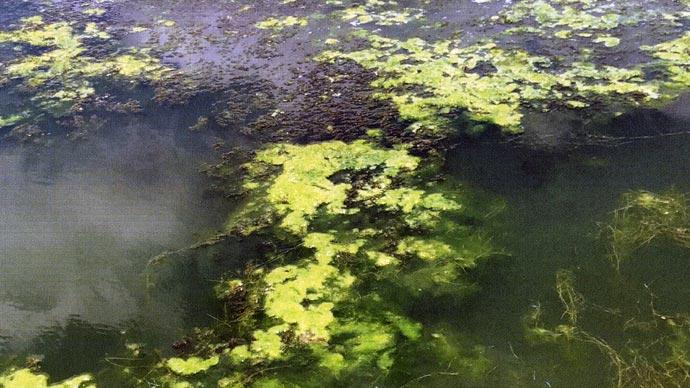
Early on in my fisheries career, I was convinced aquatic plants in a pond were bad. After all, I was trained as an aquaculturist, taught to grow as many fish as possible in a given body of water. And, for a fish hatchery that raises one species of fish in a pond, that's still the norm. No aquatic plants.
As a matter of fact, go to a fish hatchery, take a look at their ponds and you won't see a blade of grass anywhere in the water. If there is, the hatchery manager is embarrassed.
But, as I spent time in the water, pond mud squishing between my toes, dealing with runaway aquatic plant growth, studying habitat, watching fish behavior and growth, I began to see how these different elements come together to be key components of a pond's health. I've pretty much heard all the arguments from both the professionals who want to keep plants at bay and those who think plants deserve an opportunity to thrive in a given environment.
Understanding the laws of nature helps, too. Nature is always trying to seek a balance. For every positive charge there's a negative charge. It's a seesaw, rising and falling, finding a balance. When we understand that concept, we'll be better stewards of the resources in our charge.
That concept comes into play with aquatic plants, also. When the environment bends to provide all the components that aquatic plants need, they grow. Simply speaking, plants need food, sunlight and the proper temperature to thrive. Different plants require different temperatures, different types of food, and varying degrees of sunlight to thrive. Some plants dominate other plants depending on different environmental conditions. Cool water plants dominate warm water plants in cool water, but when the temperature rises, those warm water plants thrive. Some plants need high alkalinity while others thrive in acidic waters.
So what does this mean to you?
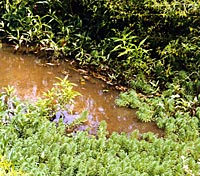
Aquatic plants are part of pond management. Different plants serve crucial roles in some ponds. Several species of pondweeds are excellent cover and a source of food for small fish. Small fish are a key component in your pond's food chain, if you are managing a multi- species fishery. Aquatic plants, in balance, add valuable oxygen during daylight hours. Some plants also serve as attractive zones for game fish to hover near as they await the appearance of the smaller baitfish.
There are several rules to live by when it comes to plants around water.
Native species are better than exotic species.
Diversity of species is much better than just having one species because multiple species tend to balance each other and live in closer harmony.
If a pond has nutrients, shallow water, and sunlight, plants will grow.
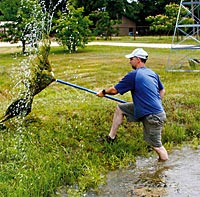
From a management standpoint, you need to know a variety of things about aquatic plants. First, know the species and how it lives. That's job one. Collect a sample of the plants you have and find out what you've got. If it's an exotic species, get rid of it. If it's a native plant, study what role it can play in your pond and then make a wise decision as to its management.
Here's a good rule of thumb. As long as rooted, underwater plants take up 20% or less of your pond's bottom, you have a healthy situation. More than 20% and it begins to be annoying. More than 50% and fishing is impossible and the fishery will be adversely affected. More than 70% in hot summer months - expect a fish kill.
What about dealing with aquatic plants in general?
Learn the species. There are several great websites to peruse, http://aquaplant.tamu.edu is a good one. Pond Boss sells a deck of cards that show many of the species which exist in North America. Find that deck, buy it and use it. Call the office and we'll send one straightaway.
Generally speaking, biologists break down aquatic plants into three basic categories: floating, emerged, and submersed. Floating plants are those such as watermeal, duckweed, azolla (waterfern) and hyacinth, to name a few. Emerged plants are those which typically grow at water's edge, with their feet wet, but with most of their parts sticking above the water line. Some of those are: cattails, reeds, sedges, creeping yellow water primrose, arrowhead, Louisiana iris, lilies, American lotus, alligator weed, and smartweed, to name a few of those. Submersed plants are numerous, too. Some of those are: Pondweeds, coontail, eelgrass, Eurasian watermilfoil, parrotfeather, hydrilla, algaes, and cabomba.
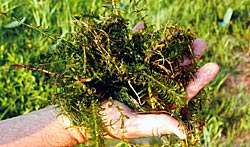
If aquatic plants are a problem, your first job is to identify the species. Once you know what you are working with, then decide on the best protocol to deal with it.
Your research may suggest the plants you have are good, native species that only grow in a small area of your pond. If that's the case, leave them alone. Those plants blend into the ecosystem, creating habitat and providing a healthy function for your water.
On the other hand, if plants have been expanding faster than Facebook on the Internet, consider a control program.
Just exactly how do you do that?
There are three basic methods for aquatic plant control. Physical, biological, and chemical methods are most commonly used.
Here's another rule to understand. When you choose any of those three control methods, you are treating a symptom of the problem. You are treating the sneeze, not the disease.
As you scratch your head pondering that last statement, here's how to understand it. The "problem" is that all the elements for plants to grow have come together - food, sunlight, and temperature. That's the true problem. If you want plants to go away, deal with any one of the "Big Three" and you'll have success. (Hint: sunlight penetration is the easiest to manipulate.)
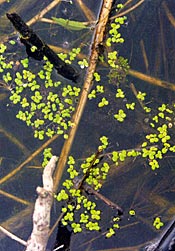
Some plants respond fairly well to physical removal. But, it's hard work. Real hard. Wet plants are heavy, smelly, and unwieldy. There are several ways to physically remove plants. There are cutters, rakes, and ingenious devices human invent, like the pondmeister who took an old, long chain link-fence gate, bolted chains to each end, threw it into the pond on the backside of a raft of plants, then used his tractor to pull the thing out. Looked like a green creature from the black lagoon. Got his kids to pick the plants off, back up and do it again, over and over until they either got tired of it or the plants gave up for the day. But, alas, the plants still did what plants do - they came back. Physical removal is organic (except when you stir up so much mud that your fish can't breathe) and takes the mass out. It also effectively removes the organic nutrients, which make up those plants. Just so you know, I'll say it again: physically removing plants is hard work.
Biological control is basically limited to just a handful of options. Aeration with microbes can often offer stability to water quality and keep nutrients recycled into the water column, where healthy amounts of plankton in the water column can take the place of noxious plants. More commonly, people use white amur, also called grass carp, to biologically remove plants. Several caveats here, though - grass carp don't eat all species of plants, so be selective about how to use them and be sure they will eat what you want to get rid of. Also, different states have different rules about how to use them. Grass carp are banned in some states and heavily regulated in others. After all, they are an exotic species. You may need a permit, so check that out before attempting to purchase them. Another caveat - after grass carp have done the job, they'll want to escape. If you wish to keep them in one spot, you'd best fence your spillway (do some research how to properly do this to not compromise the spillway function). One last caveat - be picky about the size grass carp you stock. If you have nice sized bass, don't stock small grass carp - they'll be eaten. Pick the "right" number to stock, based on your mission. Since grass carp can't be trained, guided or herded, they'll eat where they want to and pick their favorite species, first. Their favorite might not be your favorite and you'll just have to live with that.
The third method is chemical. There are literally dozens of aquatic herbicides on today's market. Most are selective to species and many have different efficacies and protocols, often based on water chemistry, temperature, and regulations where you live. The majority are contact killers, meaning they have to contact the plant to do it in. Others are systemic, while still other types must be absorbed by the plants to effectively disrupt their processes of photosynthesis and respiration.
Chemicals are, by far, the fastest way to get rid of pesky plants. But, that doesn't mean they are always the healthiest and most effective way to deal with noxious plants long term.
Always remember that any of these three methods only deal with the symptom. Don't believe for one minute that you have solved a problem when you pay big bucks to eliminate plants with herbicides. Grass carp eat the plants and convert the nutrients. Herbicides knock down one system of plants, but when the material's half-life ends, nature does what nature does - grows more plants. Same with mowing, cutting or raking them. Take those out, others show up.
And, don't ever forget: some species of plants, in moderate volume, act to promote the overall health of your pond.
This little primer on aquatic plants can help you see the thought process to making wise decisions about how to manage your pristine puddle or that fabulous bass fishing lake.
Next time you see some greenery under water, look at it through a good steward's eyes.
Reprinted with permission from Pond Boss Magazine



